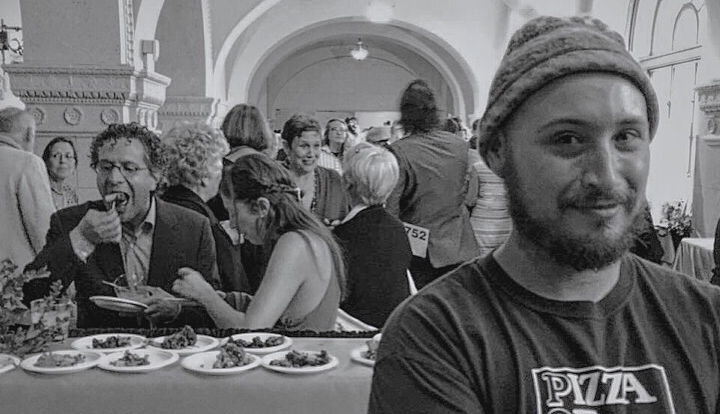When 27-year-old Jamie Woolner first opened the artisanal pizza eatery Pizza of Venice in the Los Angeles enclave of Altadena, he wanted to do food his way, and pizza was his canvas. At 23 he began creating his own concoctions, and sold his artisanal pizzas in frozen form at wholesale to a wine bar and a coffee shop. A year later he opened his own storefront restaurant, and POV has just celebrated its three-year anniversary.
“I’m too creative, I’m not good at doing the same monotonous thing over and over again,” Woolner explains. “I was a terrible employee, so I figured I should be a boss.” He had worked as a line cook at different restaurants around town. During the family meal, which is where the kitchen staff sit down and enjoy a meal together, he normally would volunteer to cook the meal. “I was just dying to make something different, to put my own personal taste on food.”
As a restaurateur, food that’s homemade and made of top-notch ingredients is top on his list of priorities. “ If I wanted to serve people shit, I would be in the manure business,” he says. “I don’t understand why people get into food if they don’t want to serve quality,” says Woolner. “They could just as easily start a Porta Potty business and get rich.”
That being said, if you have aspirations to be a restaurateur, here, in his own words, are Jamie’s top tips on what items you should splurge on and what you can skimp on when opening your own restaurant:
Fridge: Splurge
You want to buy new because you want the warranty. If something happens to say, the condenser, you want to make sure you have that insurance policy which is your warranty.
Pizza Oven: Splurge (if you can)
You can buy it used as long as you have someone who can fix it. On the other hand, I bought an oven that was bought in the ‘70s, and we went through two different mechanics, a bunch of new parts, and they still couldn’t fix it. I would say when it comes to buying equipment, if you can afford it, buy new. You don’t always have the luxury to do that. When we first got started, we bought a $900 on Craigslist glass door convection oven, which was basically a pastry oven that we hot-wired to get to 700 degrees.
The reason why we got it rid of it was our volume was getting so high that every time we opened the oven, and heat would escape and it would slow us down. One night our line cook closed the door, and the glass shattered because it was so hot.
One has to do what they must to survive. If you don’t have the luxury to get the proper equipment, you do what you have to do. With that trusty $900 oven, we got written up in the L.A. Weekly. Our pizza oven from the ‘70s was $7,000. If I was to buy the same one brand new, it would be $25,000.
Insurance Policy: Splurge
It’s like my dad says about insurance: you hope that you never have to use it. We have liability insurance, which is a $300 a month policy that covers anything that could possibly happen. If it burns down, if something happens that’s not due to just pure negligence, it’ll be covered. You can shop around for the best rates.
Seating: Skimp
Cafe-style open seating is a huge way to save money. Urth Cafe is a good example of this. They bring you food, the food is good quality but at a decent price. If it were a sit-down restaurant, you’d be spending 20-25 percent more as a customer. Labor costs is what costs you the most in the restaurant. If you can find a way to reduce labor costs, you’re killing it. Communal bar food, cafe style is a great thing. You stand in line, get a number, and have a runner give you the food.
I feel like more and more people don’t care about table service as much as they once did. They know enough about food from watching TV, they can figure out the menu description on their own. They don’t need someone to hold their hand through it.
Ingredients: Splurge
We have plates that serve our pizzas on, and we have to-go boxes. Let’s say a to-go box costs .30. We figured out the costs involved in washing a plate, and we found that it’s more expensive to wash a plate than to put it in a to-go box.
As far as ingredients go and the quality, I really believe firmly in the highest quality ingredients you can get in season. It just depends on the type of restaurant you’re opening. If you’re opening a place where the whole motto is to save money, well then the value you’re offering will be different than the value of an upscale, sit-down restaurant. You’re just not going to offer high-profile items.There’s different kind of value at Burger King than at a fancy steak restaurant.
It depends on the demographics. The standard food cost percentage that most restaurants follow, which is 20 to 25 percent of the price of the item, should go toward the food cost. So if I have a $10 item, I’ll spend no more than $2.50 on ingredients. If you’re getting into upper echelon fine dining, where you’re selling filet mignon, you’re getting more profit than Joe Schmo.
Sometimes you’re going to be spending $30 for a steak, sometimes you’ll be spending $50 for a steak. And the difference might be the level of service being provided.
At Pizza of Venice, we give people value. We definitely give them top-quality products: homemade chorizo, homemade pepperoni, and we’re curing pancetta, but we’re in a strip wall and the service is much more relaxed. It’s a more casual, friendly atmosphere.
The key is you want to give people value. You can’t just be in it for the bottom line. You can’t just do your cost-percentage analysis. You have to put yourself in the mind of the consumer. Would I be happy with this at this price? I can serve crappy burgers just like everybody else or regular cheese pizzas with processed pepperoni on top of it, and do higher volume with lower prices, but I wouldn’t charge as much and I probably wouldn’t be as happy.
Value is not quantifiable, it’s more ephemeral than anything else. Knowing what value is something you’re brought up with. Maybe you’re born with an understanding or a good palette. Having role models around you that teach you what quality is. It’s about growing up in a society and knowing what the majority of people can spend. It’s an art to know what people want. And we all know what value is when we see it.





